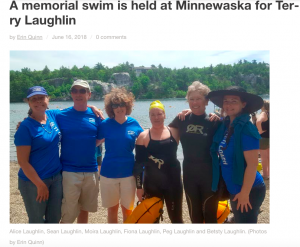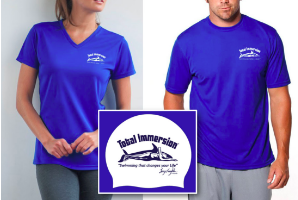Terry Laughlin's Blog, page 8
July 6, 2018
School Swimming: The Total Immersion way
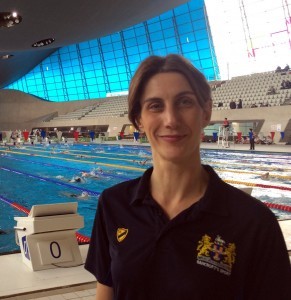
Susan Cheshire is a Level 3 Total Immersion Coach and is Head of Swimming at Bancroft’s School in Woodford Green, UK. She coaches pupils aged 7-18 and has successfully implemented the Total Immersion methodology into the PE curriculum and training of the school’s competitive teams. Susan also works with a broad range of adult clients ranging from beginners, triathletes, open water swimmers and those looking to swim for rehabilitation and fitness.
So many of us come to Total Immersion keen to swim more easily. We see a beautiful TI swimmer and think ‘I want to swim like that.’
My introduction to Total Immersion in 2011 was exactly that. When I first watched Terry and Shinji swim, their grace was utterly mesmerizing. I was already a swimming teacher in the UK, having qualified through the Amateur Swimming Association, but my swimmers certainly didn’t look like they did.
I wanted to take part in an open water event and improve my own swimming. I came across Total Immersion and their website caught my attention; “At Total Immersion we have a fool-proof approach to coaching swimming’, ‘By improving the way swimming is taught and practiced we aim to make the whole experience more accessible, enjoyable and satisfying for all.” I booked onto a two-day workshop with TI Coaches Jai Evans and Gill Anderson. That workshop transformed my swimming. The information that was delivered in a logical, sequential system of learning made absolute sense.
I had also joined Bancroft’s School in 2011, a co-educational school with 1100 pupils aged 7-18 as Head of Swimming. The PE teachers were using the same methods I had been taught during my A.S.A. training. In my first weeks, it was clear the pupils were finding swimming difficult to master. Instruction focused on pulling and kicking and many were struggling to complete the length, and there were children across all age groups still unable to swim. A school with it’s own 25m pool is no guarantee pupils will learn to swim.
After attending the workshop I knew this revolutionary method wasn’t just going to improve my swimming, but everyone’s at school.
Total Immersion was indeed about to change my life.
Following the workshop I continued to practice with a level of dedication and excitement I’d not felt before, developing my understanding further. I needed to be absolutely certain this was going to work in a traditional school environment.
In September 2013, we put away the floats and introduced Total Immersion to the PE curriculum. We made little reference to pulling and kicking, after all aquatic mammals don’t have arms or legs. The children were going to start ‘thinking’ differently about how humans swim.
The first priority, regardless of ability was for all our pupils to find their balance and comfort in the water and learn how to manage their breath. These skills quickly replaced the sinking sensation with the sense of being ‘weightless’ and supported by the water. The impact on the children was immediate and provided them with both the body control and the mental and emotional calm to learn all other skills.
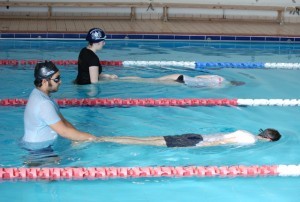
Lessons became an opportunity for mindful and deliberate practice of the ‘skill’ of swimming. Distance and speed became an outcome and not the focus of their practice. Pupils became more confident and mentally engaged. They began asking questions, and we started discussing the science of swimming. We explored our understanding of swimming as well as common misconceptions. The children were improving faster than I had anticipated.

My P.E. colleagues were learning alongside the pupils and I cannot thank them enough for trusting me when I said there was a more effective way to learn to swim. For them it felt like I had turned swimming on its head and it was a massive cultural change, but they could quickly see the positive impact it was having on the children. The school’s support has been incredible.
“We were failing pupils previously, we had numerous, quite often athletic pupils unable to swim 25m or who remained in fear of the water, even up to Year 10, we put this down to lack of time and resources. Total Immersion swimming has been the most significant development to the PE Curriculum that I have witnessed in 20 years of teaching. I look back at a career of ‘splash and dash’ teaching with nothing but regret for those pupils who have missed this wonderful opportunity”
Jonty Pollard, Head of Physical Education, Bancroft’s School
My colleagues are more confident teachers. They have a greater understanding of swimming and regularly have their own moments of magic when the children they are teaching show significant improvements during a lesson.
The vast majority of pupils are now comfortable and confident in the water. They are more efficient swimmers and the overall standard of swimming continues to improve. Swimming is inclusive and representative of the school diversity. The programme continues to evolve and our pupils regularly work in pairs, sharing the roles of pupil and coach. This has allowed them to develop their observational and communication skills, and has really helped to cement their understanding giving them the knowledge to improve and practice independently away from school.
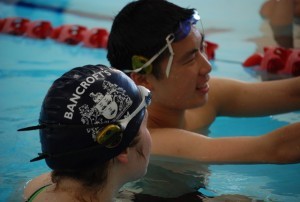
The number of swimmers attending after-school training has increased significantly; with over 110 children training weekly.
In 2017 97% of our Year 4 Pupils (Aged 8/9) achieved 25m and 61% of our Year 6 Pupils (Aged 10/11) swam 200m.
“My daughters confidence and swim technique has improved immensely since swimming with you at Bancroft’s. She continues to swim at our local leisure centre; she swam more than 1000m front crawl effortlessly this evening.” Mrs Sangha, Year 4 parent
The children are faster in competition, the standard of our annual inter-house galas has improved, and most importantly levels of participation are much higher at over 90%. Pupils continue to swim outside of school, taking up triathlon, open water swimming and joining local swimming clubs.
“I have been at Bancroft’s since I was 7 and I am now 15. I arrived in the prep school a confident swimmer, but not an efficient one. Despite swimming at school since year 3, it is only in the last 4 years that my swimming has really improved. Swimming used to be a chore, and many who came to the prep had not improved a huge amount by the end of year 6. Not so when the Total Immersion program was introduced. Taking apart my stroke and rebuilding it step by step, as well as understanding the science behind the technique, has transformed my swimming and allowed me to compete and I feel confident in my swimming that I now swim in the sea on holiday.“ Eleanor, 15
A growing number of our pupils are volunteering with our Community Swimming project, allowing local children with Special Educational needs the opportunity to learn to swim.
‘Total Immersion is a significant and brilliant progression in teaching swimming and I value it as one of the most important things in school. I am still improving and I hope to swim a lot more in the future.” Kemi, aged 18
It’s been an incredible challenge and I’ve loved every minute. I continue to enjoy improving my own swimming and am looking forward to my next open water adventure.
The post School Swimming: The Total Immersion way appeared first on Total Immersion.
June 22, 2018
Remembering Terry with a Memorial Swim
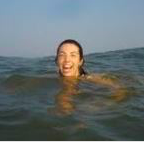 Carrie (Laughlin) Loveland has been playing in the water for as long as she can remember! Growing up, she swam competitively for several years and was just 10 years old when her father, Terry, founded Total Immersion Swimming in 1989. She began assistant coaching at Total Immersion weekend freestyle workshops in 1999, when she was a sophomore at Wesleyan University. Following college, she coached several competitive youth teams, including Schwimmclub Meilen in Zurich in 2003 (where she learned to coach in Deutsch!), Cheyenne Mountain Aquatics in Colorado Springs in 2004, and finally, the New Paltz Hawks from 2004 to 2007. Since 2005, she has taught at the Total Immersion Swim Studio in New Paltz. The studio setting allowed her to significantly expand her skill set to include infant and toddler lessons, children of all ages and abilities, adult water-phobic and beginner lessons, as well as the classic T.I. “swimming improvement” classes for adults. In addition, she holds an M.S.Ed (with a focus on early childhood) and has considerable experience working with both mentally and physically disabled students. She is an avid open water swimmer and competed in the 2007 USMS 2-Mile National Championship in Lake Placid, where she placed first in her age-group. Her passion is giving the gift of harmony and enjoyment in the water to as many people as she can.
Carrie (Laughlin) Loveland has been playing in the water for as long as she can remember! Growing up, she swam competitively for several years and was just 10 years old when her father, Terry, founded Total Immersion Swimming in 1989. She began assistant coaching at Total Immersion weekend freestyle workshops in 1999, when she was a sophomore at Wesleyan University. Following college, she coached several competitive youth teams, including Schwimmclub Meilen in Zurich in 2003 (where she learned to coach in Deutsch!), Cheyenne Mountain Aquatics in Colorado Springs in 2004, and finally, the New Paltz Hawks from 2004 to 2007. Since 2005, she has taught at the Total Immersion Swim Studio in New Paltz. The studio setting allowed her to significantly expand her skill set to include infant and toddler lessons, children of all ages and abilities, adult water-phobic and beginner lessons, as well as the classic T.I. “swimming improvement” classes for adults. In addition, she holds an M.S.Ed (with a focus on early childhood) and has considerable experience working with both mentally and physically disabled students. She is an avid open water swimmer and competed in the 2007 USMS 2-Mile National Championship in Lake Placid, where she placed first in her age-group. Her passion is giving the gift of harmony and enjoyment in the water to as many people as she can.
On Saturday, June 9th, 175 swimmers and numerous volunteers gathered at Lake Minnewaska for the inaugural “Terry Laughlin Celebration Swim” — the first open water memorial event for Terry this season, put on by Dave Barra and his organization, New York Open Water (NYOW). After a relatively cool May and early June, we were lucky enough to be graced with warm, sunny weather and a water temperature of about 70 degrees. Designed as a non-competitive event, the swim was a triangle course of 0.75 miles, in which participants were invited to swim whatever distance they desired in the allotted time of 3 hrs, from 10 A.M. to 1 P.M. Many swimmers chose to do a quick sprint distance with just one loop of the course, while a surprisingly large number swam continuous loops until the clock ran out. It was a relaxed and convivial atmosphere– one Terry would have certainly reveled in– and the swimmers were extremely well-supported by the volunteers for the event.
(Video and photos below courtesy of Bob Fagan at USIA Video )
Located in Minnewaska State Park, near Terry’s hometown of New Paltz, NY, Lake Minnewaska is a pristine mountain lake nestled atop the Shawangunk Ridge ( “The Gunks” to locals) and was Terry’s favorite and most frequent spot to swim, featured prominently in much of his writing and videos. He never missed the chance to join the Minnewaska Distance Swimmers’ opening day toast with season-fresh local strawberries and a group song, “This Lake is Your Lake” (sung to the tune of “This Land is Your Land,” by Pete Seeger, another Hudson Valley resident with a passion for our local waterways). Always a bit mournful on the last day of swimming at the lake on Labor Day, Terry immediately looked forward to the opening day of swimming in mid-June the next year… nine months away! Lake Minnewaska was, without a doubt, a second home to him, so much so that he even requested that some of his ashes be scattered there.
As one of his daughters, it felt like the perfect way to remember our dad. Last August, on a long drive home after the two of us swam a 2.5K race in Lake George (the last swim event in which he competed), we spoke a lot about what a beautiful swim we were able to share there and how grateful he was to still be able to swim, even as Stage 4 cancer took its toll on him. While our family always strived to remain optimistic as his health declined, the shadow of his cancer’s steady march was always in front of us. So, with that in mind, I said to him: “Dad, let’s imagine you live a long time… Someday–hopefully in the far future, not necessarily soon– would you want a memorial swim named for you after you die?” He said, “Yeah, yeah… that would be great. I’d love that… That would be really nice.” When I asked him to specify where, he said he’d have to think about it– he had so many favorite swim spots over a lifetime of swimming open water around the world– but I knew he was thinking about Minnewaska.

It’s the first season I (and so many who loved him) have ever swum there without him, so it was bittersweet, and a bit surreal, to not see him there with all of us– but he was absolutely there with us in spirit. It’s almost impossible to take a stroke there (or anywhere) and not think of him. And as a little symbolic gesture, I had his laminated membership card for the MDSA (Minnewaska Distance Swimmers Association) with me as I swam the event. For the entire swim, I was picturing him swimming along with all of us around the lake, enjoying his favorite activity in his favorite place, on such a spectacular day. I was imagining him sync swimming next to me, matching the rhythm of each of my strokes with his own, just as we did on countless swims throughout my life. It was very touching to see all the people who came out that day to honor him and celebrate his life, his passion for swimming… and his zest for life itself! This event was truly a life’s dream for him and although it wasn’t originally planned as a memorial swim, I’m so glad that Dave had the chance to tell him it was finally happening, when he visited Terry during his final week of life in the hospital last October.
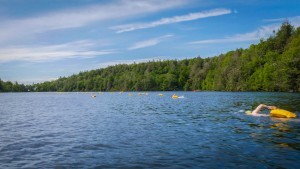
The Laughlin family extends our huge thanks and tremendous gratitude to event director and close friend of Terry’s, Dave Barra, and his organization New York Open Water for putting on an amazing memorial swim at his home lake, to honor and celebrate Terry’s life, his friendship, his love of swimming, his contributions to the sport, and his enduring positive influence on the people whose lives he touched. It was a fantastic event and we had a beautiful day of swimming and open water camaraderie! Thank you also to Minnewaska State Park for allowing NYOW to host this event at Terry’s favorite spot to swim, and thank you to the park employees and the local EMS crew who supported this event. Thanks to all the volunteers who came out to help, including: the volunteers for NYOW, Terry’s wife Alice Laughlin and numerous members of the Laughlin family, staff and former staff of Total Immersion, Keith Woodburn, Tracey Baumann, Angela Dorris, Carsten and Krisha Patenaude Stoever, Jim and Denise Ullrich, Clare Kelly and Bob Fagan.
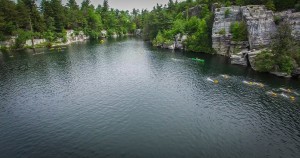
And, of course, THANK YOU to all of Terry’s friends, colleagues and coaches, fellow community members, T.I. students and fans, former swimmers from Terry’s teams, and open water enthusiasts who came out for this memorial celebration swim! It was a great day and fantastic swim because of ALL OF YOU! Thanks again to everyone– it really meant so much.
A beautifully written account of the memorial swim, written by Erin Quinn, appeared in last week’s New Paltz Times. Erin is the Head Coach of Hawks Swimming and is also an Award Winning Journalist who has written for The New Paltz Times, The Woodstock Times, The New York Times and Swimming World Magazine.
REMEMBER TERRY!
Get your Limited Edition Terry Laughlin Signature Sports Tee Shirt and Swim Cap now.
CLICK HERE
The post Remembering Terry with a Memorial Swim appeared first on Total Immersion.
June 15, 2018
It Matters How Your Breathe
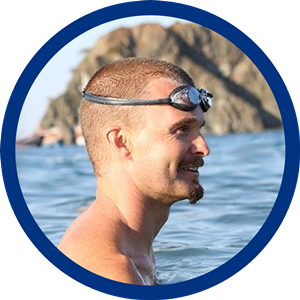 Coach Mat Hudson currently resides in Salem, Oregon, his homestate, with his wife and 4 children (yes, they all swim TI!). He recently returned from 8 years living on the Mediterranean Coast in Turkey.
Coach Mat Hudson currently resides in Salem, Oregon, his homestate, with his wife and 4 children (yes, they all swim TI!). He recently returned from 8 years living on the Mediterranean Coast in Turkey.
He has been training as a serious swimmer for nearly 30 years, and enjoys a particular focus on marathon distance in open water. He trains in pool and sea and practices all four stroke styles in the TI way.
Mat provides private lessons, workshops, open-water camps and online coaching services for swimmers around the world. He has taught swimming in 12 countries. He has worked with students from 5 continents, all ages, and from fitness and pleasure, to channel swimmers, to pro triathletes. Consider visiting and subscribing to his prolific blog Smooth Strokes (www.mediterraswim.com/blog/) started over 5 years ago with nearly 400 posts full of inspiring stories, technical insights and solutions for excellent swimming with a complete body and mind.
Obviously, your brain handles all your daily breathing without the need for you to control it or even think about it. But do you know how you breathe in daily life? I mean, do you know which part of your body, which muscles do most of the work for each breath? Do you know that breathing can be done in different ways? Do you know if it matters or not?
Perhaps you are one of those trained in martial arts, yoga or some other sport or body-aware practice that teaches a certain breathing technique, and you understand how it works and why it is important to do it that way. Even if so, when you get in the water, does that awareness and technique come along with you while you swim?
Breathing Checklist
Over the years, from being confronted with several common complaints about breathing I have developed a checklist for systematically testing and revealing the specific areas that contribute to a particular swimmer’s breathing struggle. It is rarely just one thing, but a convergence of a few gaps in skill that set up the struggle. Each person may have a unique combination of those. My checklist (which you are can read here) is long but organized and prioritized. To reveal individual errors, I can view the swimmer during a few laps to spot any obvious ones and make some educated guesses for which items on my list we should check for, which can save us some time in testing. Then we follow a patient process of swimming short repeats while we work down that abbreviated list. Taking one item at a time I give a focal point for each repeat and the swimmer uses that focal point to examine a particular detail in their pattern, looking for differences between their non-breathing strokes and the breathing stroke, or looking for differences between the left side and the right side breathing action. Rarely is someone totally symmetrical. When one difference is uncovered we apply a correction with that particular focal point and test again to see how much it improves the breathing action.
My preliminary checklist (there is an advanced one too) is organized into these four sections:
Position (of lead arm and head)
Timing (of the turn and return of the head)
Air Management (for exhale and inhale)
Breathing Pattern (relative to intensity and tempo)
Under each of these sections there may be many specific focal points we could examine, each one contributing some benefit to breathing action.
Between my observations and working through these sections of skill we may expose and solve most common complaints.
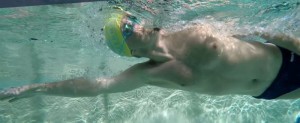
When Stroke Skills Are Not Enough
However, some swimmers return who have been faithfully practicing initial breathing skills for weeks and months, yet still complain of feeling short of breath. Occasionally, one comes back with technique refined enough that I cannot reconcile the amount of breathlessness he still complains of with the apparent efficiency of his movement patterns. Even if technique was not close to perfect, the shear amount of swimming he has done should be producing more compensatory fitness than it has. So what’s going on?
I’ve learned now to make more observations. One of those is to watch swimmers as they are resting at the wall – specifically, I watch to see how they do their exhale and inhale while standing up. I watch to see which is predominant: does their upper chest expand and shoulders lift then fall, or does the chest stay still while the belly bulge out then pulls back in on each breath?
In other words, I look to see if this swimmer is a chest breather or a diaphragmatic breather, because how he is breathing while standing at the wall is likely how he is breathing while swimming, or worse.
Breathing from the upper chest (known as thoracic breathing) is a technique meant to turn on in fight-or-flight situations, or in extremely high-intensity exercise efforts, but not for everyday activity or endurance-type exercise. Instead, our bodies are designed to predominantly use diaphragmatic breathing (so called ‘belly breathing’) and derive great health and exercise advantage from it. However, though we started out breathing this way as babies, for some mixture of reasons, modern life may (it is said) de-trained over 80% of people to no longer breathe this way. You might be one of them.
Improve Your Swim, Improve Your Health
Let me share some recent comments made by Robert, one of my swimmers, after we introduced this change into his breathing…
This afternoon I spent a couple hours just working a length or lap at a time using the breathing technique you recommended. I went very slow and just tried to breath the new way. My natural technique seems to be exactly the opposite.
Last week I would be in huge oxygen debt nearly the entire time I was swimming those longer distances. I was extremely uncomfortable for most of the swim. Using your recommended technique each day I was able to swim more laps without a sense of oxygen debt and when I was in oxygen debt it was not as severe. So I was much more comfortable during these recent long swims.
Today on my long run I practiced this breathing the entire time. It is difficult to tell for certain (there are always other factors that could be in play – including my distorted perceptions) but I think the change in my breathing routine made a lot of difference in my run today. It was easier.
I think changing my breathing technique is going to be a GAME CHANGER in my swimming development.
Now I feel that breathing has been the fundamental problem all along. It fits in so many ways as the cause and solution.
During my practices of the last few days I monitored and redirected my breathing. I can tell from these practices that when I am not struggling so much for oxygen I can better control my body. When I’m in oxygen debt I’m not able to control my body very well – I am mostly trying to get air. So I think once I can breathe better (using the technique you recommended) I will be able to get the swimming skills I am working on to “stick”.
If you are breathing from the upper chest, not only are you going to suffer in exercise, you may be setting yourself up for disease also:
The textbook, Respiratory Physiology (West, 2000), suggests that the lower 10% of the lungs transports more than 40 ml of oxygen per minute, while the upper 10% of the lungs transports less than 6 ml of oxygen per minute. Hence, the lower parts of the lungs are about 6-7 times more effective in oxygen transport than the top of the lungs due to richer blood supply mostly caused by gravity.
During thoracic breathing, lower layers of the lungs, which are most valuable in oxygen transport, get much less, if any, fresh air (less oxygen supply). This causes reduced oxygenation of arterial blood in the lungs and can lead to so called “ventilation-perfusion” mismatch (as in COPD or emphysema). Normal breathing is diaphragmatic, allowing homogeneous inflation of both lungs with fresh air, similar to what happens in the cylinder of a car engine due to the movement of the piston.
Breathing technique that is not suited to the activity – namely, upper chest breathing – could explain a swimmer’s breathlessness after short distances. Breathing from the upper chest is like trying to swim at 14,000 foot elevation! Under that air-restricted condition, even one who can swim continuously for hours at sea level would feel breathless in a couple lengths!
If you’ve been swimming regularly, a few times a week, for many months, yet you are still feeling breathless after a few laps, or even after many minutes of what should be moderate swimming, then you may consider this to be one of the prime suspects.
Recommendations
For sake of space I won’t go into a full lesson about how to breathe from the diaphragm. You can look at TI Coach David Shen’s blog post on Abdominal Breathing and you may find a consensus on Youtube for how to test and practice this kind of breathing… on land. The trick here is to translate that into the water where you are weightless and horizontal and your brain may be occupied with other priorities. But, the brain is also very concerned about getting enough air exchange, and if you’ve been suffering from breathlessness, you may feel enough motivation to turn attention to focus on diaphragmatic breathing as a possible solution.
If you suspect this may be one of your problems, here is a recommended approach:
Practice diaphragmatic breathing while resting at the wall. It will permit a better recovery.
Practice any time during the day, when it comes to mind, even for a few minutes or a few breaths. You can start to build a mindful habit for this.
Set aside some time in swimming to focus only on this. It may take all your attention just to breathe in a new way.
Here are some instructions you may try out to get you going with this in your next practice time:
When you rest at the wall, place one hand flat below your navel and breathe deeply so that each inhale presses that hand out (bulging the belly) and each exhale pulls the hand back in toward the spine. On the inhale you can feel the diaphragm pushing downward on the intestines and the pelvic floor for a good visceral massage. [Note: as you will see in Coach David’s blog post, there is more to good technique than just pushing the belly out and in. My recommendation here is just to get you started in the right direction with few words. Please study the technique more thoroughly.]
When swimming, concentrate on regulating the exhale with the compression of the diaphragm. With the intention to exhale only about half (or less) of the air in your lungs, begin exhaling gently from the nose, and gradually increase the rate until your face turns and touches the air, ready to inhale. You have an extended amount of time during the non-breathing strokes to think about exhaling from the diaphragm, and then you can let the very brief inhale take care of itself, to refill the volume you just pushed out.
Outside of pool practice time, you may lay in plank position, long and braced, and then practice breathing deeply with the diaphragm. This will show you how one set of core/abdominal muscles can be activated to bridge and stabilize the long body line while there is still room and enough relaxed tissue to permit full, deep breathing. In plank (and variations of it) I always practice diaphragmatic breathing and only through the nose. I count breaths to measure time in that position, which further reinforces full, earnest exhale and inhale.
You can practice diaphragmatic breathing just about anywhere in daily life, whenever ever it comes to mind. Even doing just two or three breaths this way at random times of the day – sitting, standing, driving, cooking, laying down – can gradually retrain a preference to breathe this way again all the time. The more you do it on land as a habit, the more easily it will transfer into your swimming.
May you breathe much easier, in the water and out!
The post It Matters How Your Breathe appeared first on Total Immersion.
May 19, 2018
When We’re Mindful, We’re Alive.
This is the third in a series of blog posts we’ll be pulling from the archives. We miss Terry dearly, but do find co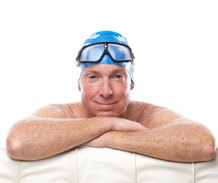 mfort in re-reading pieces he’d written when he was in good health and spirits. Terry’s optimism and lust-for-life comes through loud and clear in his writing, and we hope you’ll find these posts both inspirational and informative.
mfort in re-reading pieces he’d written when he was in good health and spirits. Terry’s optimism and lust-for-life comes through loud and clear in his writing, and we hope you’ll find these posts both inspirational and informative.
This article was originally published in October, 2014.
Ellen Langer, at age 67, is the longest-serving psychology prof at Harvard. What she is best known for is studies which have shown that people can make marked physical changes, improving health, reversing aging effects, etc. in response to mental suggestions, which she calls primes.
The New York Times Magazine just published an article about Langer’s work What If Age Is Nothing But a Mindset. This excerpt from that article describes mindfulness in a way that applies exceptionally well to improvement-oriented swimming practice.
“If people could learn to be mindful and always perceive the choices available to them, Langer says, they would fulfill their potential and improve their health. Langer’s technique of achieving a state of mindfulness is different from the one often utilized in Eastern “mindfulness meditation” — nonjudgmental awareness of the thoughts and feelings drifting through your mind — that is everywhere today.”
“Her emphasis is on noticing moment-to-moment changes around you, from the differences in the face of your spouse across the breakfast table to the variability of your asthma symptoms.”
When we are “actively making new distinctions, rather than relying on habitual” categorizations, we’re alive; and when we’re alive, we can improve.
A key goal of TI Focal Point Practice is precisely as Langer defines it–to replace habitual perception by pursuing new distinctions.
For instance, the first step in improving Balance is to get the head into an aligned and buoyancy-neutral (‘weightless’) position. But muscle memory can impede this change. To make the change we need to be able to make finer distinctions between when the head is slightly elevated, exactly in equilibrium, or slightly depressed.
Or as Langer says, “actively making new distinctions.”
We do that in TI practice by combining three kinds of focus–internal, external, and visualization.
For head position these are:
Internal: Release your head’s weight by relaxing neck and upper back muscles.
External: Feel the water’s density as a ‘pillow’ cushioning the weight of your head.
Visualization: Visualize a laser projecting forward from your head-spine line.
And by using Focal Points like these, you should be able to achieve head position as aligned as this.
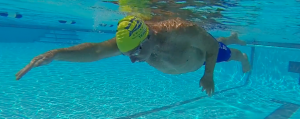
The post When We’re Mindful, We’re Alive. appeared first on Total Immersion.
May 12, 2018
An Open Water Swimmer’s Journey: Raising the Bar, and Raising Awareness
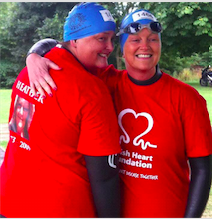 Helen and Hayley Brant’s journey began 5 years ago when they decided to raise funds for the British Heart Foundation by taking part in the Marlow Open Water and the Great London Open Water Swims in memory of their younger sister, Heather, who passed away from an undetected heart condition in December, 2009. In honor of their sister, TI swimmers Helen and Haley turned to open water swimming to cope with their grief and raise funds for the British Heart Foundation. Read more about their campaign here.
Helen and Hayley Brant’s journey began 5 years ago when they decided to raise funds for the British Heart Foundation by taking part in the Marlow Open Water and the Great London Open Water Swims in memory of their younger sister, Heather, who passed away from an undetected heart condition in December, 2009. In honor of their sister, TI swimmers Helen and Haley turned to open water swimming to cope with their grief and raise funds for the British Heart Foundation. Read more about their campaign here.
It’s been said that people who embark on extreme challenges usually have a story to tell. December 16th 2009 is the day our story started. Our younger sister, Heather, was an incredible woman who gave so much of herself to so many and her untimely passing from an unknown heart condition was a shock to us all. She was just 36.
People react to grief in many ways. How it affects you and how long it lasts depends on many things. It was my older sister, Helen, who first suggested that we take up an open water swimming challenge, both as a coping mechanism and to raise funds for the British Heart Foundation in Heathers memory.
After months of self-coaching the next chapter of our story was written. It was 23rd August 2013 and we found ourselves on a stretch of the River Thames in Marlow, Bucks. Through the driving rain we reviewed the 1 mile course from left to right. This was our very first open water timed event. Adrenaline took over as we entered the water for a mass start countdown and the sound of the starters horn. We still laugh now at the lesson we quickly learned – unless you’re planning on a hard, fast race, don’t position yourself front and centre. We exited the water some 40 minutes later, both exhausted and thrilled at what we had accomplished. We wanted to find a way of involving Heather, so we asked the organisers if they would put some flowers in the water for us. They were so willing to get involved and positioned them beautifully on the edge of the finishing gantry. It was wonderful to see them as we approached the end of the swim.
The gesture of including flowers has gone on to become a ritual that motivates and inspires us at all our events. Organisers have been only too happy to help by laying them in the water along the route and rewarding us with a 3rd medal. Over the years, we amassed a healthy collection of medals and every summer we take them with us on our annual trip to Cyprus. Cyprus holds some amazing memories for us as children, especially a small jetty where played and swam together. Our visits to the jetty are usually spent sharing our stories with Heather and leaving that year’s medal collection in a secret place for our mermaid sister to enjoy.
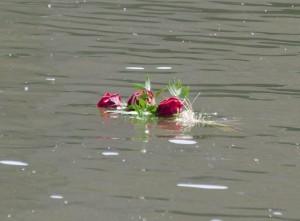
For the next 2 years we continued to self-coach and to raise the bar in terms of the distance. We entered a Coniston End to End swim in 2014 (8.5km) and then the Jubilee River swim in 2015 (10km), both of which were hugely out of our comfort zones and we were delighted to be able to complete them.
Fast forward to December 2015 and with long distance events booked in the River Thames and Lake Windermere, as well as thoughts of an English Channel Relay, we both agreed that we should consider some coaching. We had spent the winter dipping in the River Thames and one swimmer caught our eye. His stroke was so clean, smooth and effortless. He talked enthusiastically about ‘T.I.’ and within a matter of weeks Helen and I were booked for our initial assessment with Tracey Baumann.
We arrived for our assessment in January 2016, nervous and excited. Tracey’s facility and the technology she uses is first class and she spent time getting to know us, our goals, analysing our stroke and talking through the Total Immersion process. Although we had already completed a few long-distance swims, we were by no means experts. I think every swimmer wants to go ‘faster’ but what we really wanted to know was how we could swim for even longer and go further. By the time we left, we knew that we had embarked on a journey of discovery that would shape us to be the best swimmers we could be.
Our lessons continued and with patience and pride Tracey taught us the fundamentals of Total Immersion, carefully explaining the ‘what’ AND the ‘why’, to impress the importance of each focal point and its relationship with other elements of the stroke.
Week after week we practised hard and the excitement around our progress led to talk of an English Channel Relay once again. We were already booked to do the swims that soloists would consider in the run up to a crossing, so this seemed to make perfect sense. We spent time with Tracey filling our ‘Toolbox’ as she would call it, and many hours practising together. It wasn’t long before our confidence started to grow along with a belief that we could actually do this. Our Total Immersion journey had literally stripped us back to the basics of swimming, even undoing habits we thought impossible to undo. We were rapidly improving and refining our technique as well as being educated on the importance of balance and stability to make us more streamlined in the water.
Every year we had committed to raising the bar and just 3 months after our Total Immersion training started, we booked our English Channel 2-Person Relay window for September 2017. Team Aitch Sea Jays was born!
We still had some challenging swims ahead of this, including a Lake Windermere End to End (18K), so the training and coaching with Tracey continued in earnest. We worked hard together and on longer swims we took it in turns to suggest different focal points to work on. By the time our swim arrived, we were ready. Helen had been carrying a shoulder injury but had worked with Tracey to make some adjustments to her technique that offered some relief on longer swims. It was an early start with flat calm conditions and things got underway strongly. At around the 7km mark Helen started to experience increasing pain in her shoulder. Quite remarkably, she swam for a further 4.5km before finally having to call her swim. We had always completed all our swims together but selflessly she urged me to continue and I went on to finish.
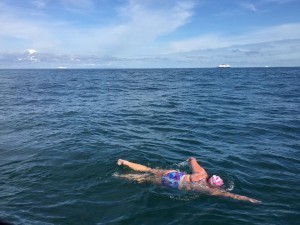
We both gained so much from our Windermere experience and we channelled (no pun intended!) all of it into building a plan for the ‘big one’! Following a short rest, we were back in the pool for a winter season of coaching with Tracey that would see us ready to join other 2017 English Channel hopefuls on Swimmers Beach in Dover.
By now our stroke was unrecognisable from that first lesson and video footage in January 2016. Total Immersion is an ongoing learning cycle and our desire to swim for longer and go further was fast becoming a reality. We spent a lot of time working on single elements of our stroke, sometimes using a whole training session to just nail one thing! We were spending almost every weekend in Dover, challenged by the ever-changing conditions and trying to maintain good form. For most the season, we opted to do more than the standard ‘2-dips’ if time allowed, regularly doing 3 or 4 with a 30-minute break in between. It was all great preparation for the big event and on Sept 18th, 2017, a little after 5am, our swim began. We had discussed in detail what would motivate us and we arranged for some of the focal points to be laminated in large print. We were diligent in adopting one focal point every hour, and using this to try to exit the water as better swimmers. Our moment of glory came 19hrs and 19mins later when Helens hand touched French sand. We have both since agreed that if we’d been asked to keep swimming, we could have. Our return to the UK following that swim saw us stop slap bang in the middle of the English Channel to lay our flowers for Heather. This ritual will never change.
We will end this blog by saying that grief stays with you, it becomes part of you. Our decision to do something for ourselves and the charity we strongly believe in has been a life changing experience for countless reasons. The introduction to Total Immersion gave us the confidence and strength, both physically and emotionally to achieve things we never thought possible.
Helen and I have different goals for the coming seasons, but swimming will always be something we do together. Helen has her sights on an Ice Mile and one of the Scottish Lochs and I have just completed my 6-hour qualifier for an English Channel Solo in June 2019. Every day, we know that Heather is watching and that she is immensely proud of us.
The post An Open Water Swimmer’s Journey: Raising the Bar, and Raising Awareness appeared first on Total Immersion.
May 5, 2018
[VIDEO] Terry’s last public talk: Barcelona, December 2016
In December of 2016 my parents and I went to Barcelona and Alicante Spain together for a combination of Total Immersion events including this talk and a teacher training workshop. It was the last TI trip that I went on with my Dad after a lifetime of swimming trips together. In Barcelona we were hosted by Sergi Mirapeix who set up this event for a group of swimmers, and thankfully recorded Terry’s talk. It’s the last public talk he gave and is full of wisdom and humor as usual (see reference to having been born with a suit, cap and goggles at the end). Enjoy.
–Fiona Laughlin
The post [VIDEO] Terry’s last public talk: Barcelona, December 2016 appeared first on Total Immersion.
April 27, 2018
Examples Of Tension And Relaxation In Freestyle
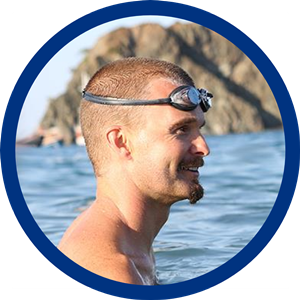 Coach Mat Hudson currently resides in Salem, Oregon, his homestate, with his wife and 4 children (yes, they all swim TI!). He recently returned from 8 years living on the Mediterranean Coast in Turkey.
Coach Mat Hudson currently resides in Salem, Oregon, his homestate, with his wife and 4 children (yes, they all swim TI!). He recently returned from 8 years living on the Mediterranean Coast in Turkey.
He has been training as a serious swimmer for nearly 30 years, and enjoys a particular focus on marathon distance in open water. He trains in pool and sea and practices all four stroke styles in the TI way.
Mat provides private lessons, workshops, open-water camps and online coaching services for swimmers around the world. He has taught swimming in 12 countries. He has worked with students from 5 continents, all ages, and from fitness and pleasure, to channel swimmers, to pro triathletes. Consider visiting and subscribing to his prolific blog Smooth Strokes (www.mediterraswim.com/blog/) started over 5 years ago with nearly 400 posts full of inspiring stories, technical insights and solutions for excellent swimming with a complete body and mind.
(This is an addendum to Wednesday’s post, The Tension Behind Relaxation).
Some Examples Of Tension And Relaxation In Freestyle
There could be hundreds of focal points for building appropriate tension and relaxation throughout the stroke – far too many to discuss in a blog post. But here are some areas in the freestyle stroke you may observe this relationship…
The Head
The ‘weightless head’ we work on first and foremost in the freestyle stroke is an obvious point of energy savings. Since the head naturally floats – with a small part of the back of the head above the surface – in perfect position to stay aligned with the spine, the swimmer does not need to use any muscle activation to hold the head up or push it down into position. The pressure of water pushing up does all the work. The swimmer only activates the slightest amount of muscle to keep the head centered in front of the spine, as the tip of the torpedo, driving straight ahead down the lane.
The Spine
The spine is the axis of the whole freestyle stroke and is holding tension-in-alignment the entire time. “Use the core’ or ‘engage the core’ may be too vague of a command for the spine. Rather, I prefer to use the instruction ‘be long and firm as if standing on your tippy toes’ (or shortened to the focal point ‘Tippy Toes’). The tension in the core of the body that we want comes from the lengthening of the torso, not from contraction. There is nothing rigid to push against externally, so it is a lengthening that happens inside, with the body pushing and pulling against itself (a concept called tensegrity, coined by Buckminster Fuller), to make it longer and thus firmer. The internal stabilizing tissues around the spine and through the pelvis and down into the thighs become long and firm like cables on a suspension bridge, locking the body into that long, firm position. This tension might be perceived at about 20% of maximum and is held continuously the entire time, never turning off the whole time we are stroking.
The under-trained swimmer tends to have rigid, tense appendages and a noodle-like spine that bends in all directions to accommodate those flailing arms and legs. We want to reverse this completely. The spine becomes long, straight, firm, and the appendages learn to be accommodating to the spine, learning to move parallel to it, never pushing or pulling laterally against it.
Skate With Recovery
The Skate side of the body is long, stretched (not twisted or strained), and firm like a ‘skate blade’ or a ‘cross country ski’ while the recovery side is fluid and relaxed, allowing a frictionless swing of the arm. It is the quality of firmness on the Skate side which permits the fluid swing of the other arm. When the swimmer is not fully extended in Skate Position, the rotated torso is less stable, and the recovery swing feels more rushed, more disruptive to balance.
The Arm Stroke Cycle
When examining just one arm moving through the entire stroke cycle, we see muscle ‘pulsing’, where much of the muscle units are relaxed during the recovery swing (especially the forearm and hand and fingers) and then activated as the catch is set and continues during the pull phase, then they turn off again as the forearm reaches the waist. These muscles are turning on-then-off-then-on-then-off, and so on cycle after cycle. This relaxation during part of the stroke cycle reduces the overall average number of muscle units that are cranking out waist products making it easier on the circulatory system to remove them. And it conserves energy, keeping muscles at rest when there is no need for them to be working. The visibly-relaxed wrist, hand and fingers during the recovery swing reveal something about how well the swimmer is pulsing this part of the body.
The Catch And Hold
During the so-called ‘pull phase’ of the underwater stroke, what we prefer to call the Catch and Hold, the arm and shoulder muscles lock the arm into ideal catch shape and then the torso takes most of the load for applying pressure against the the water, to urge the body to slide forward past that point. Instead of softening up the catch arm in a misunderstood application of relaxation, there is appropriately applied tension, where some parts of the arm hold position with just enough muscle tone, while the back and trunk muscles move more powerfully. This more ideal muscle choreography permits a more powerful stroke that lasts longer because the muscles work better in proportion to their size and endurance. This is experienced as a contextual form of relaxation – muscles working hard but harmoniously.
The post Examples Of Tension And Relaxation In Freestyle appeared first on Total Immersion.
April 25, 2018
The Tension Behind Relaxation

This article was written by TI Coach Mat Hudson.
Coach Mat currently resides in Salem, Oregon, his homestate, with his wife and 4 children (yes, they all swim TI!). He recently returned from 8 years living on the Mediterranean Coast in Turkey.
He has been training as a serious swimmer for nearly 30 years, and enjoys a particular focus on marathon distance in open water. He trains in pool and sea and practices all four stroke styles in the TI way.
Mat provides private lessons, workshops, open-water camps and online coaching services for swimmers around the world. He has taught swimming in 12 countries. He has worked with students from 5 continents, all ages, and from fitness and pleasure, to channel swimmers, to pro triathletes. Consider visiting and subscribing to his prolific blog Smooth Strokes (www.mediterraswim.com/blog/) started over 5 years ago with nearly 400 posts full of inspiring stories, technical insights and solutions for excellent swimming with a complete body and mind.
Understanding Relaxation In Context
Often, I hear a swimmer describe how eager they are to find that wonderful relaxation in the stroke that Coach Terry described. For some, adding more relaxation will bring a great breakthrough. However, for others, it could be a mistake, depending upon their interpretation.
The instruction to ‘Relax!’ has a context. Taken in context it will make swimming feel and flow better. Taken out of context and the swimmer will be left wondering why their body isn’t going forward very well.
There are three main ways a swimmer may have inappropriate muscle activation and need to apply more relaxation:
There might be excessive tension – where there are more muscle units being activated than are necessary to get the work done.
There might be misplaced tension – where muscle units are being activated in the wrong spot.
There might be mistimed tension – where the muscles are being activated at the wrong moment.
Any and all of these add up to a body with excessive and antagonistic tension, a body that is working against itself, which is exhausting.
But what is also implied here is that a certain arrangement of beneficial tension is also necessary for swimming to feel and flow well. To experience the kind of smooth, beautiful and powerful swimming that you aspire to, you need to apply both relaxation and tension, in the right places, at the right time, and in the right amount.
Depending on what part of the body is being worked on, you might actually need to increase tension, rather than reduce it. It’s about arrangement. You are ultimately aiming for a swimming action that is smooth, apparently relaxed, yet amazingly powerful. Appropriate tension combined with appropriate relaxation allows greater power to flow, more safely and more enjoyably through the body.
Relaxed… Compared To What?
When working toward the ideal arrangement of tension and relaxation your application of each depends on whether you have too much or too little. If you have misunderstood the relationship and arrangement of tension and relaxation then your swimming will not flow like you hope it will.
In my experience, maybe more than half the swimmers that show up for coaching attention for the first time have too much movement and too much muscle activation going on. So the general benefit of the first lessons are to help them strip away the excess movements, the excess tension, the excess exertion and bring it down to only what is absolutely necessary for moving forward. But certain tension is still required.
Then there are swimmers that show up too relaxed, too gentle in their touch, and too ‘noodle-like’ in their spine. They do not have enough muscle activation going on. The first lessons also point out how the body needs to be shaped and then held in place by appropriate tension, so that other fluid, relaxed movements can be anchored to that firm tensile frame.
The command to relax has a specific context. It is not a blind, absolute command for the whole body. It applies to those parts of the body that have inappropriate tension. It does not apply in the same way to those parts that are too loose, too soft, too noodle-like already.
All instructions and corrections have a particular context. They are meant to take some specific part of the body or movement pattern and move it closer to the ideal from the direction of a particular kind of error, like moving from the side towards the center of a bulls eye. But a misunderstood instruction, or an instruction applied to the wrong context can overshoot the bulls eye to create an error on the opposite extreme. So it is important to understand the specific context of the command, such as “Relax!”.
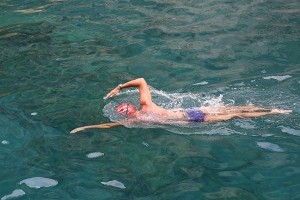
Relaxation Is A Result Of Refinement
The better the arrangement of tension in the body – the right place, at the right time, in the right amount – the more relaxation you can experience. Appropriate tension in one part of the body permits relaxation in another. There is a relationship, a dynamic balance between them. You need one to have the other, and as the stroke moves through the cycle, their arrangement changes accordingly.
There is a general process we follow to create a smooth, powerful stroke, which is summarized in an old martial arts mantra: slow is smooth, smooth is fast.
In your initial lessons to learn or to correct movement patterns, you slow down, not in order to relax, but in order to etch a more precise movement pattern. As you carefully repeat this precise movement in a variety of drills and modes, it gets integrated more deeply into the neuromuscular system. The more integrated it becomes the more smoothly, the more powerfully your brain can execute that movement, with less effort. Through attentive practice, the brain figures out how to set tension in the right place, at the right time, in just the right amount. As this process unfolds, you experience more relaxation, without necessarily focusing upon it directly. Your sense of ease increases, which means your body is adapting to the work, refining, becoming more efficient at executing the movement. Then you are ready to turn up the intensity – with higher standard of precision, with more tempo, with more power, or with longer duration – and work through the process of refinement further, and so on. In this way you tap into relaxation at higher levels of performance.
Likewise, using focal points, you more easily learn to send precise signals to parts of the body by working on small pieces of the stroke choreography at a time. You train one part to hold essential tone, while you train another part to stay relaxed in relationship to it. Initially, it is challenging to do both at the same time. The signals to tense or relax need to be sent to the right parts. The signals need to be sent at the right moment – there is a timing for when to turn on or to turn off certain muscles. These signals need to be sent with proper intensity – there is an amount of muscle tone that is just right, not too much and not too little. This arrangement is sensed and controlled entirely through your nervous system (spread throughout the whole body, not just in the brain). Improving your awareness and interpretation of the signals from your own nervous system is absolutely critical to improving this arrangement.
Note: I have some examples to share from the freestyle stroke of this relationship between tension and relaxation which I’ll include in part 2 of this article.
Power Plus Relaxation Is Wonderful
Relaxed swimming is not necessarily slow swimming, though slowing down, at first, may be what you need to do to tap into relaxation. Relaxation is actually a quality that will be attached to any speed, any intensity you may want to swim, when properly combined with tension. The faster you want to swim, the more critical appropriate relaxation is in order to remove the internal hindrances to speed. But do not mistake relaxation for lack-of-effort. If you turn off the wrong part, turn off at the wrong moment, or turn off too much, then you have relaxation which takes away from your progress rather than enhances it.
Appropriate placement, timing and amount of muscle tension creates a body that moves smoothly, without internal conflict. Movements can be powerful but they are smooth and thereby it feels good even to swim at high power, high exertion. Your skill for relaxation is genuinely tested when you turn up the power.
What we ultimately want is a properly toned body and movement pattern – with certain parts being activated with tension at the right moment, in the right amount, while other parts are yielding and moving smoothly, without internal resistance. This artful arrangement of tension and non-tension is the overall ‘relaxation’ we are aiming for, with adjustments in that arrangement at all different levels of speed and intensity. This kind of relaxation feels wonderful and it looks wonderful!
The post The Tension Behind Relaxation appeared first on Total Immersion.
April 15, 2018
Creating Beauty (getting speed in return)
This is the second in a series of blog posts we’ll be pulling from the archives. We miss Terry dearly, but do find co mfort in re-reading pieces he’d written when he was in good health and spirits. Terry’s optimism and lust-for-life comes through loud and clear in his writing, and we hope you’ll find these posts both inspirational and informative.
mfort in re-reading pieces he’d written when he was in good health and spirits. Terry’s optimism and lust-for-life comes through loud and clear in his writing, and we hope you’ll find these posts both inspirational and informative.
This article was originally published in October, 2012.
I spent the first week of October at a TI Open Water Camp in Turkey. On our last full day, we did an ‘adventure’ swim. A group of nearly 30 swimmers and coaches left our base at Ugur Pansiyon, near Cirali, and swam north, around a nearby headland, to a remote bay, usually accessible only to intrepid hikers. I wondered if we might have been the first group to ever visit the bay that way. We swam in three groups, organized by speed, escorted by kayaks carrying snacks and water.
I swam with the fastest group-several campers and two coaches, our ages ranging from 40+ to 60+. We followed the least direct route, not only to coordinate our arrival with slower-swimming groups, but to explore the rugged shoreline. We swam over submerged boulders and crevasses, beneath looming cliffs and, once, between the rock wall and a rock pillar. At times there was barely room–vertically and/or horizontally–to squeeze through in single file. With our leisurely pace and meandering route, it took about an hour and 40 minutes to reach our destination, where we shared our good fortune in being able to explore ‘Planet Water’ in ways that only a vanishingly small number of our species are able.
But the best part was yet to come. After hydrating and snacking (we had kayak support) we returned by the most direct route and at a brisk pace, taking just 50 minutes to get home. What I love most about open water swimming—even more than exploring hard-to-reach places—is a form of collaboration or teamwork not possible in the pool. On our return, we swam for nearly two miles in a tight formation–five abreast. I was in the middle with two swimmers to each side. The entire time we were separated by inches, regularly brushing arms, hips or shoulders, yet never distracted or impeded by contact. For long stretches we also swam in near-perfect synchrony—five hands entering the water at the same moment . . . that looked like this:
(Video shot and edited by Johnny Widen)
But the best part was the sheer beauty I observed each time I took a breath. Whether I looked left or right I never saw a single droplet of splash and each arm was poised identically—gracefully–for a deft, clean entry. And though we were swimming into a stiff breeze, which pushed waves against us, below the surface I glimpsed four identical, sleek-and-stable bodylines, and not a single bubble–looking more like aquatic creatures than human swimmers. As I told my partners after we finished, staying in formation and synch that way for 50 minutes made it the best swim I’d ever been a part of.
Reflecting on this later that day, I recalled the first day of my coaching career, just over 40 years earlier. Within the first 10 minutes—standing on deck surveying 15 swimmers, rather than with my face immersed as it had been the previous seven years—I noticed that every swimmer in the pool appeared asymmetrical. Those who breathed to the right (bilateral breathing was still rare in 1972) twisted their bodies toward that side and those who breathed left torqued that way.
The next day I instructed the team to breathe on the ‘wrong’ side and all were symmetrical. While I can say with complete confidence that symmetry enhances speed, I found it more enjoyable to watch swimming—something I would spend tens of thousands of hours doing in ensuing decades–when the movements were more aesthetically pleasing. And seeing how quickly I could improve the aesthetics of my swimmers encouraged me to perform more such experiments and led to an extraordinary team performance at season’s end.
Forty years later, TI Coaches now have a detailed understanding of human biomechanics and fluid dynamics and can precisely describe the mechanical advantages of a balanced bodyline, fluent strokes, seamless breathing and well-tuned kick. Yet our strongest motivation remains that which I discovered on my first day as a coach—that creating beauty in a swimmer is even more satisfying than producing speed. We know, for instance, that a Geometric Recovery and Mail Slot entry improve lateral stability, channel more power from the weight shift into propulsion, and maximize natural leverage in the armstroke. Yet the most satisfying aspect of teaching them is the far deeper pleasure of creating beauty.
If there’s one thing more satisfying than creating beauty in other swimmers, it’s doing it with others. While swimming in the middle of the group, I also strove to reflect back the graceful lines I saw to either side and am certain the others did too. And that all of us likely thought about how we looked to observers on shore as we left the beach starting our swim or approached it at the finish.
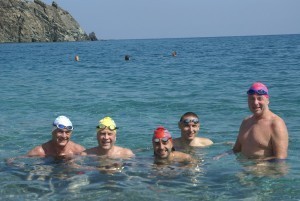
In swimming beauty consistently leads to speed. Two of us have won open water national championships in middle age–Lennart in Sweden and me in the U.S. Yet, while both of us talk frequently about how much we enjoy swimming in synchronized grace with fellow swimmers, I can’t recall any mention of how it feels to beat others across a finish line.
The post Creating Beauty (getting speed in return) appeared first on Total Immersion.
April 6, 2018
Balance – In Water and On Snow
This is the first in a series of blog posts we’ll be pulling from the archives. We miss Terry dearly, but do find co mfort in re-reading pieces he’d written when he was in good health and spirits. Terry’s optimism and lust-for-life comes through loud and clear in his writing, and we hope you’ll find these posts both inspirational and informative.
mfort in re-reading pieces he’d written when he was in good health and spirits. Terry’s optimism and lust-for-life comes through loud and clear in his writing, and we hope you’ll find these posts both inspirational and informative.
This article was originally published in January, 2011. We thought it was appropriate because, even though it’s April 6th, we’re watching snow fall outside during our annual strategic planning session in New Paltz, NY.
Yesterday was my first day of cross-country skiing this winter. It was my best ‘first day’ ever, and in the Top Ten of all days in nearly 20 years of skiing. I do a form called Freestyle or Skating, which requires a stronger sense of balance than the more familiar Classic style.
Skating looks like it sounds. You glide and push in a V-pattern – a shallow V on a gentle downhill, slightly wider on flat terrain; spread your ski tips more on uphills. It’s like this: Lift one ski and step toward that side. Roll toward your instep — keeping the heel weighted — as you push outward, shifting your weight — and hips — the other way. Lift the other foot, drawing it toward the pushing ski, then step the other way and repeat.
I’m not remotely as skilled as this, but this short video will give you the idea.
If your timing and balance aren’t precise, it’s exhausting. When you get them right, it’s magic — fluid, rhythmic and easy — even on moderate uphills. I skied the Overcliff Trail at Mohonk Preserve yesterday. It’s dazzlingly scenic, but the first kilometer (KM) is gradually uphill. Usually I find myself sweaty and tired as I reach the highest point, but yesterday, while I still didn’t have the timing and balance, I wasn’t struggling and felt relatively fresh as I completed the uphill. Then it turns slightly downhill for the next KM and I just sailed. I sometimes test balance on gradual downhills by seeing how long I can glide on one ski with the other slightly raised. Yesterday I glided quite far with one ski raised.
I continued over rolling terrain for an hour, then turned back. When I reached the KM I’d glided over earlier – now an uphill – I changed strategies. I would only continue so long as I felt rhythmic ease. The moment I felt struggle I would pause for 5 slow nose-breaths, while visualizing rhythmic ease. I completed about five cycles like this. Each time I sustained rhythmic ease a bit longer after the pause. Finally, the sense of gliding uphill remained constant until I completed the rising KM. The final KM, now downhill, was simply the best I’ve ever skied.
I pondered why I felt so good, despite having skied only once in nearly two years (I spent most of last winter in San Diego training for swim marathons). Possibly because I’d roller-skied twice a week since mid-November. But perhaps also because I spent last week swimming in ‘rolling terrain’ at our Open Water Experience in Maho Bay in the US Virgin Islands, teaching balance, relaxation and rhythm to 28 open water enthusiasts. On our final day I accompanied a group for a 5k swim. Most had little or no prior open water experience and this would be their longest – and most open - swim ever.
I paddled for the first 2.5k, then traded places with Dave Barra for the return trip, and swam with them while he paddled. The observations I made while paddling gave me a clear sense of priorities for any swimmer who wishes to be balanced, relaxed and rhythmic in waves and chop. In other words to be able to swim farther than you ever have before, enjoy it more, and feel energized when you finish.
1) Keep your head low. This is critical to balance — i.e. keeping your hips and legs near the surface — at all times. And usually this is less of an issue in salt water. But in waves or chop, less experienced swimmers tend to lift the head while breathing. This would sink their legs, and increase drag. They would barely regain balance before breathing, and losing balance again. Keep your head low while breathing. Roll more if chop makes it harder to breathe.
2) Breathe bilaterally. When breathing to one side, every cycle, it’s hard to extend fully to a long, streamlined position. Breathing every 3 strokes allows 2 strokes of unimpeded extension. It also means you don’t have one side that’s permanently shorter because of single-side breathing (the right side for a left-breather.) Note: In the race excerpt shown at 1:26 below, you see me breathing only left. That’s because the shoreline was to my left and I navigated at that point by following it. Others kept looking forward, but it was much easier to keep my head low by navigating this way. This is more important than bilateral breathing. In the rest of the video [and other parts of that race] I breathe to both sides.
3) Enter through a Mail Slot. Hand should enter first, cleanly. Then slide forearm, cleanly, through the ‘slot’ cut by your fingertips. (A relaxed hand and forearm on recovery is necessary for this.) This puts your hand 12 to 18 inches below the surface as you complete extension. This (i) aids balance and relaxation and (ii) puts your hand in the best position to begin the next stroke.
In this video, note how I use pool and open water practice to wire my brain so strongly around these habits that – in contrast to everyone around me in the race section (2006 World Masters Championships) – they don’t break down in rough water or the pressure of a race.
The post Balance – In Water and On Snow appeared first on Total Immersion.
Terry Laughlin's Blog
- Terry Laughlin's profile
- 17 followers


